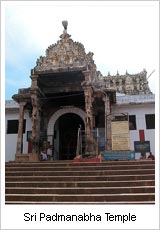Introduction:
The capital of Kerala, Thiruvananthapuram is said to be built
on seven hills, and carries the ancient traditions of the
state since 1000 BC. Also known as the “City of the Sacred
Serpent,” the land derives its name from the sacred serpent
of Lord Vishnu, Anantha. This beautiful seaside city is spread
over an area of 2,192 sq km and has been the capital of the
region since the reign of the Raja of Travancore in 1750.
Over the decades, Thiruvananthapuram has been an erstwhile
city from the perspective of trade and culture. Not surprisingly,
post independence, when the state of Kerala was formed in
1956, Thiruvananthapuram was considered as the ideal candidate
for the capital. Thiruvananthapuram city is considered as
one of the loveliest cities in India. Built on seven low coastal
hills, the city has an interesting mixture of tree-lined avenues.
Massive buildings, ancestral homes and a long sea coast washed
by the waves of the Arabian Sea. Clean, green Thiruvananthapuram,
with its spacious layout and regulated life, is also an excellent
base to explore the interiors of Kerala. It is bordered by
Kollam district in the north, Thirunelveli and Kanyakumari
districts of the State of Tamil Nadu in the east and south
and the Arabian sea in the west. Thiruvananthapuram is a beautiful
city of magnificent structures built on seven hills with anceint
and modern style of architecture. Many important cultural
institutions, palaces, art galleries, beaches and Sree Padmanabha
Swami Temple are located here.
Thiruvananthapuram, the city of the sacred serpent, with its
winding cobbled lanes, traditional red tiled wooden houses
with pagoda tops and languid pace receives a modest nimber
of tourists. But not for long. Kerala is the hottest item
on the tourist map of India and Thiruvanthapuram is its gracious
capital city.The capital city from where the world’s first
elected Communist government governed is tucked into the lower
part of southern Kerala, part of what was ravancore.
A pleasant city in one the most beautiful states in India,
Thiruvananthapuram merits more than just a transit meal on
the way to Kovalam Beach. The main city is characterized by
beaches and narrow winding lanes. The ancient culture of the
city is reflected in the old buildings and tapered, dusty
lanes. The chief hub of the city is the M.G. Road, which is
the main commercial center with most of the industrial and
official buildings located in the vicinity. Although a number
of hotels and lodges are located here, the quieter and peaceful
ones are located close to the sea. All the main sights of
interest are also located nearby, within a distance of 4 km,
north or south. The chief transport centers such as the railway
station and the bus stand are also located near M.G Road.
FESTIVALS & FAIRS
Festivals and fairs have always been
a part of india and will stay so forever to add to India's
colour and integrity. Take a look at fairs and festivals of
this country in order to become a part of the same. India
is a land of festivals and fairs.Every festival has some or
the other traditional or religious importance.Every day of
the year there is a festival celebrated in some part of the
country. Some festivals welcome the seasons of the year, the
harvest, the rains, or the full moon. Others celebrate religious
occasions, the birthdays of divine beings, Saints, and gurus
(the revered teachers), or the advent of the new year. A number
of these festivals are common to most parts of India, however,
they may be called by different names in the various parts
of the country or may be celebrated in a different fashion.
Every festival is celebrated in a unique style
Sightseeing:
Sri Padmanabhaswamy Temple:
The temple, located near the bus stand at East Fort, is the
city's most impressive landmark. Its 7 stored gopuram built
in the 16th Century is one of the finest specimens of traditional
South Indian temple architecture which reflects the Kerala
influence. The temple corridors are lined with 368 sculpted
stone pillars. Beautiful murals and ornamentation adorn the
walls. Temple was renovated by the Maharaja of Thiruvithamcur
in 1733. Only Hindus can enter the temple, wearing dhoti in
a certain style. Sankumughom Beach, This palm-fringed beach
near the airport, with its indoor recreation club and children's
traffic training park is fine for an outing-though not for
swimming.
Vizhinjam:
An important fishing port near Kovalam beach. Here, one can
see fishing boats return with their catch in the mornings.
Kovalam:
A beautiful, curving, palm-fringed beach of golden sands and
safe bathing have made India's major beach resort. It is an
internationally known holiday destination. This natural bay
is a safe sea-pool free from high waves and surges - ideal
for swimming, surfing and skiing. The more adventurous can
ride out into the sea on a catamaran. Besides the ITDC's luxury
hotel complex, several other hotels and guest houses have
sprung up on the hillsides overlooking the beach, taking advantage
of the Kovalam boom. Among the many other attractions here
are water sports, a theatre that stages traditional Kathakali
dance dramas, a yoga centre and facilities for traditional
oil bathing and massages according to the ancient Kerala Ayurvedic
system. | |

|

